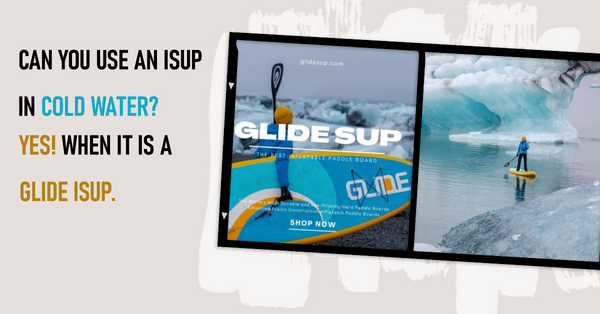
Can You Use an iSUP in Cold Water? Tips for Cold Water Paddle Boarding
Paddle boarding doesn’t end when summer does. With the right gear, PSI, and safety prep, your iSUP is ready for winter adventures in cold water.
Paddle boarding doesn’t have to stop when the temperatures drop — it just takes the right preparation. With the right gear, technique, and awareness, paddlers can confidently embrace the chill and discover the quiet beauty of winter waters.
This guide explains how to safely and comfortably enjoy cold water paddle boarding using an inflatable SUP.
It covers how cold temperatures affect air pressure and performance, what to wear (from wetsuits to drysuits), and essential safety practices for winter paddling.
You’ll also learn the importance of group paddling, route planning, and proper iSUP maintenance in cold weather.
Introduction
Cold water paddle boarding might sound intimidating, but with the right gear, preparation, and mindset, it can be one of the most rewarding experiences on your SUP. Crisp air, glassy water, and total solitude — winter paddling offers a side of nature most people never see.
Inflatable stand-up paddle boards (iSUPs) are perfectly suited for these chilly adventures thanks to their durability, stability, and buoyancy. However, cold weather affects both your board and your body, so understanding how to adapt is key to staying safe and comfortable.

❄️ Understanding the Cold-Water Challenge
Paddling in water below 70°F (21°C) demands extra attention. The biggest risks are hypothermia and reduced muscle control, so preparation matters more than ever. The good news? With proper equipment and awareness, cold-water SUPing can be completely safe — and incredibly peaceful.
Key Takeaways:
-
Cold air and water cause air pressure to drop, softening your board if not adjusted.
-
Proper insulation keeps your body temperature stable, preventing cold-shock responses.
-
Planning and paddling with partners reduce risks and increase fun.
💨 How Cold Affects iSUP Performance
Cold temperatures can impact your inflatable paddle board’s rigidity and PSI. As air contracts in low temperatures, your board may lose firmness — even if you inflated it to full pressure earlier.
Here’s how to keep your board performing perfectly:
-
Inflate to the upper end of the recommended PSI range before paddling.
-
Recheck air pressure after 10–15 minutes in cold water.
-
Use a high-quality pump with a gauge for accurate readings.
-
Choose a board with woven drop-stitch construction and fused PVC rails, like Glide’s AeroMatrix™ and ThermoFuse™ tech — they stay stiffer and more reliable in all temperatures.
-

🧥 Gearing Up for Cold-Water SUP
The right apparel makes or breaks a winter paddle. Dress for the water temperature, not the air temperature, and remember that conditions can change fast.
What to Wear:
-
Wetsuit or dry suit: A 4/3 mm wetsuit works for water above 50°F (10°C); colder than that, go with a full dry suit.
-
Neoprene boots and gloves: Keep your extremities warm — that’s where heat loss starts first.
-
Thermal base layers: Moisture-wicking, quick-drying layers underneath your suit boost warmth.
-
Hat or hood: Over 30% of body heat can escape from your head.
-
Avoid cotton: It stays wet and draws heat away from your skin.
🛶 Cold Water Paddle Boarding Safety
Even seasoned paddlers should treat cold-water SUPing with respect. These precautions can make all the difference:
-
Never paddle alone. Cold water saps energy fast — always bring a friend.
-
File a float plan. Let someone know where you’re going and when you’ll be back.
-
Use a leash and PFD. Staying attached to your board means staying afloat.
-
Stay near shore. Cold water slows rescue times — stay within swimming distance.
-
Know hypothermia signs: Shivering, slurred speech, or confusion mean it’s time to get out.
-

🔧 Caring for Your iSUP in Cold Weather
Cold conditions can shorten the lifespan of your gear if neglected. To keep your iSUP adventure-ready all winter:
-
Before paddling: Check PSI, fins, and seams for wear.
-
After paddling: Rinse with fresh water, dry thoroughly, and store in a warm, dry place.
-
Avoid freezing storage areas: Freezing temps can cause valves or seams to expand.
-
Top tip: Slightly deflate your board before long-term storage to reduce material stress.
🌅 Why You Should Try Winter SUP
Winter paddling isn’t just about endurance — it’s about serenity. Calm water, no crowds, and a renewed connection with nature make cold-water SUPing a completely different kind of joy.
Benefits include:
-
Peaceful, crowd-free waters.
-
Improved mental focus and cold-weather resilience.
-
A stronger immune system (thanks to cold exposure).
-
New adventures year-round — not just summer paddling.
-

✅ Final Thoughts
Cold weather doesn’t have to end your SUP season. With the right gear, preparation, and mindset, your inflatable paddle board can handle cold-water paddling with ease. Stay aware of your surroundings, dress smart, and embrace the tranquility that winter brings.
Glide’s line of durable, adventure-ready iSUPs is designed to perform in all conditions — from tropical bays to icy alpine lakes. So grab your board, layer up, and paddle into the stillness of winter with confidence.
🧠 FAQs: Cold-Water Paddle Boarding
Can inflatable paddle boards handle freezing temperatures?
Yes — high-quality iSUPs like Glide’s are built with fused PVC layers and drop-stitch cores that stay rigid and safe in cold weather.
What PSI should I inflate my board to in cold water?
Inflate to the upper end of your recommended range (around 18–20 PSI) to compensate for air contraction.
Should I deflate my iSUP after cold-water use?
Yes. Let it dry completely, then partially deflate before storage to prevent seam stress.
Is cold water SUP dangerous?
Not if you prepare properly — wear a wetsuit or dry suit, use a leash and PFD, and never paddle alone.
What’s the best iSUP for cold water?
Glide’s AeroMatrix™-built boards with ThermoFuse™ rails perform exceptionally well in variable temperatures.





